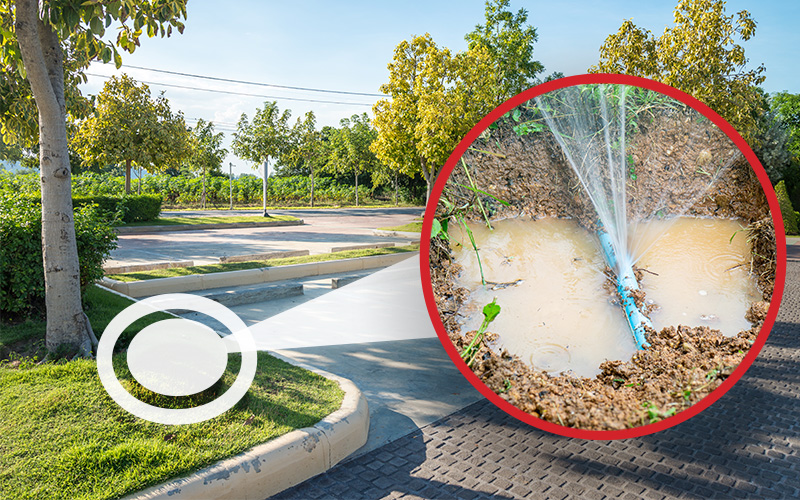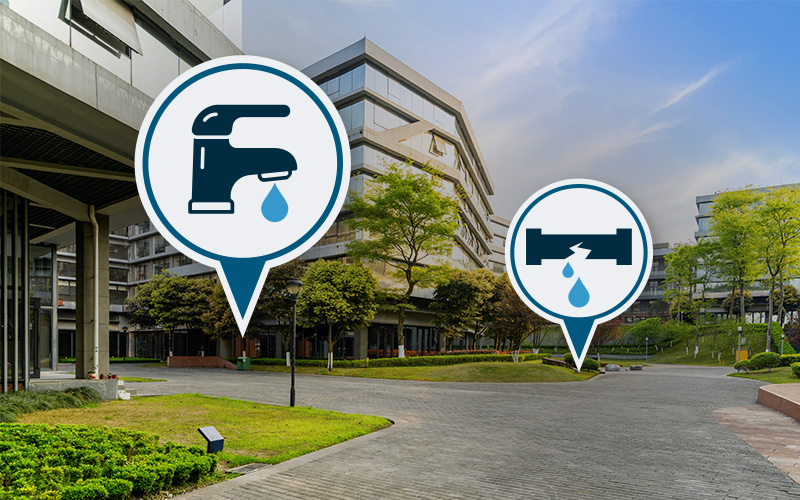
The BaseStation 3200S site management controller provides users with more control and more information than ever before. It supports the patented two-wire technology from Baseline, as well as conventional wire and retrofit solutions. Its advanced flow management features and flexible communication options allow users to network devices through the cloud or using a local area network.
The BaseStation 3200S combines soil moisture sensor-based intelligent watering technology from Baseline with the industry’s best practices for weather-based irrigation into a single user interface. The BaseStation 3200S can help you reduce water use by up to 62 percent.
Existing BaseStation 3200 controller displays, operating system, and firmware can be easily upgraded – click here for details
Register your BaseStation 3200S Controller here.
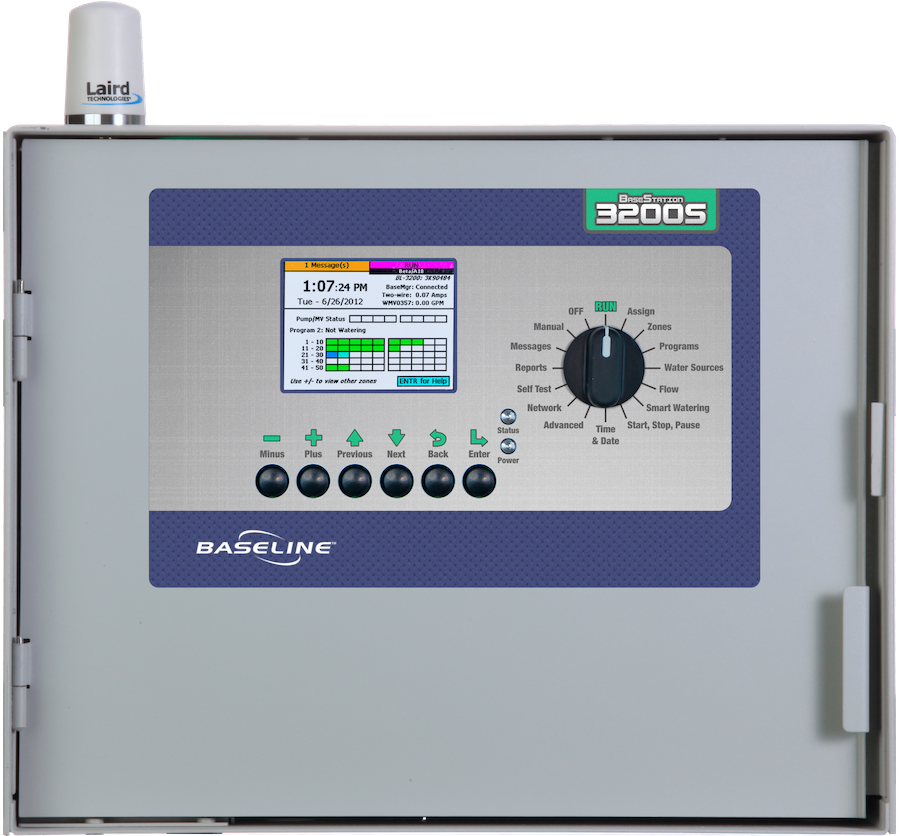
Engineered for Intelligent Site Management
The BaseStation 3200S leverages its unique responsive technology and performance components to support up to 99 concurrent zones and manage non-irrigation zones with ease.
Solving Problems in Real Time
- Real-time data means you can control what you need to when you need to
- Smart watering with moisture sensors can save up to 62 percent versus standard water methods
- Responsive flow management and data analytics gives you the ability to optimize water resources
- Dynamic central control capabilities save you time and resources
- Leak detection programming will stop leaks fast and alert you in real-time
Responsive, Real-Time Technology
Every BaseStation 3200S supports all of our responsive two-wire devices right out of the box. The strength of our two-wire solution comes from its patented, true two-way communication. This means our devices provide real-time data where you need it, when you need it.
Flow Optimization
The programming and features of the BaseStation 3200S enable you to take precise control over the water at your site. You can manage every aspect of flow starting from the water source to control point (a master valve, pump, or a hydrometer) to the mainline and down to the zone. The Baseline irrigation controller software learns the flow for each zone, maximizes the number of zones it can turn on at once, and helps shorten your water windows.
Efficient Resource Management
In order to water smart, comply with water regulations, and prevent over-watering and runoff, you also have to know when to stop irrigating. You can guess or you can measure.
Baseline soil moisture sensors measure the actual soil moisture content where it really matters — in the root zone. With average water savings of 62 percent, we can show you how to use less water while optimizing plant health. You can determine exactly how much to irrigate and when field capacity is achieved. This information allows you to start, stop, or pause irrigation programs according highly accurate data.
WeatherAccess™ for BaseManager provides a platform that combines our soil moisture sensor-based intelligent watering technology with the industry’s best practices for weather-based irrigation into a single user interface.
Get Real-Time Alerts, Messages, and Reporting
Every BaseStation 3200S includes a built-in Ethernet port so the controller is Internet-ready out of the box. Wireless connectivity options include Wi-Fi, cell modem, and spread-spectrum radio.
BaseManager™ is a powerful cloud-based central control and remote access platform that allows any BaseStation 3200S controller to be managed remotely over the Internet.
Scale Site Management with the FlowStation and the SubStation
With the addition of a FlowStation™, you can monitor and manage water resources across as many as 20 BaseStation 3200S controllers.
Flow Management: The FlowStation maximizes the number of valves and controllers that can operate at once based on the amount of water that is available. Multiple BaseStation 3200S controllers can operate simultaneously and the FlowStation will manage which controllers get water and how much they are allowed to use.
The SubStation™ wirelessly connects to the BaseStation 3200S controller using ethernet radios or wireless network. Once networked, the BaseStation 3200S can program and run all zones and devices connected to a SubStation. Obstacles for a wire path such as roadways, water features, or buildings are easy to plan around with SubStations.
A single BaseStation 3200S can connect with up to eight SubStations, and because each SubStation has its own 24 volt transformer, the BaseStation 3200S can run up to 99 zones concurrently thus dramatically reducing water windows.
Features that Matter
- Supports up to 200 zones
- Supports two-wire and conventional wire
- Supports up to 25 soil moisture sensors
- Supports up to 99 programs
- Supports up to 8 water sources
- Supports up to 8 points-of-control
- Supports up to 8 mainlines
- Supports up to 99 concurrent zone operations
- Includes advanced flow management and monitoring features
- Uses pressure readings to start, stop, and pause management and monitoring features
- Supports weather-based watering
- Includes built-in Ethernet port
- Supports Wi-Fi, cell modem, and spread spectrum radio
- Prioritizes based on control point or program
- Supports Intelligent Water Rationing™
- Integrates with any FlowStation™ or SubStation™
- Supports controller-level tiered passcodes
- Includes detailed, on-screen instructions and help
Solutions for Your Project
The BaseStation 3200S offers irrigation features that can help you manage any landscape project you might have. New construction or retrofits, big projects or small, the BaseStation 3200 has the solution for:
- School districts
- Parks departments
- Municipal landscape departments
- College and University campuses
- Commercial properties
- High-end residential properties
- Homeowner’s Associations
- Water-harvesting projects
- LEED projects
- Building management projects
- Professional athletic stadiums
- Sports turf and playing fields
- Greenhouse and hydroponic projects
BaseStation 3200S Specifications
BaseStation 3200S Display Features
- High contrast 3.5 inch TFT LCD screen
- Screen resolution is 320×240 at 65,536 colors
- Screen brightness of 200 lumens for easy viewing in direct sunlight
BaseStation 3200S Smart Watering Modes
In addition to time-based watering, the BaseStation 3200S can also be operated in the following smart watering modes:
Soil Moisture Sensor-Based Watering
If you have a Baseline soil moisture sensor (biSensor™) installed in your landscaping and connected to your BaseStation 3200S irrigation controller, you can program the controller to water based on the moisture levels in the soil.
Weather-Based Watering
When operated in WeatherAccess™ mode with an active BaseManager™ Plus subscription, the BaseStation 3200S irrigation controller meets the EPA WaterSense program’s water-efficiency and performance criteria.
On the BaseStation 3200S, you can combine Baseline’s soil moisture sensor-based intelligent watering technology with the industry’s best practices for weather-based irrigation.
BaseStation 3200S Operating Features
- Supports up to 200 zones along a two-wire path and/or a conventional wire path
- Supports up to 25 moisture sensors
- Supports up to 8 temperature sensors, which monitor and control program operation based on temperature thresholds
- Supports up to 8 devices with contacts that alternate between open and closed (known in Baseline terminology as event switches)
- Supports up to 8 water sources
- Supports up to 8 independent mainlines for control and management of separate water delivery systems
- Supports up to 8 hydraulic components known as “control points.” The control points accept input from:
- Up to 8 normally open or normally closed master valves
- Up to 8 pump starts
- Supports up to 8 flow sensors or meters, including indoor flow sensors and hydrometers
- Up to 8 pressure biCoders, which accept 4-20 mA inputs from pressure transducer devices
- Supports up to 99 completely independent programs
- Supports up to 8 available addresses for TCP/IP-based connections. These addresses are used to connect the following performance components:
- Baseline’s FlowStation
- Baseline’s SubStation
- The Munro Pump Station
- The controller supports concurrent zone operation.
- In stand-alone operation, the controller’s transformer supports a maximum of 15 concurrent zones.
- When operated in conjunction with Baseline’s SubStation, the number of concurrent zones will increase by 15 zones with each additional SubStation. With 8 SubStations, the controller supports a maximum of 99 concurrent zones.
- Over conventional wire, the controller operates up to 2 typical solenoids per 12-station powered biCoder or up to 4 typical solenoids per 24-station powered biCoder plus 2 additional solenoids using the VE00001 and VE00002 ports.
- Device Assignments
- The controller searches for and identifies all devices connected to the two-wire and lists them according to device type and serial number.
- The controller is capable of addressing or re-addressing any two-wire decoder (biCoder) from the controller by re-assigning the device’s serial number to a new zone address.
- The controller assigns any station or terminal number on a multi-station biCoder from the controller to any zone address in any order, in any program.
- The controller allows any device to be removed, replaced, or reordered.
- The controller supports full two-way communication with all devices and monitors two-wire voltage and communication integrity, solenoid voltages, current, and status (reported as open/short/OK).
BaseStation 3200S Programmable Features
- Program up to 8 start times per program in 5-minute increments
- The controller automatically stacks overlapping programs.
- The controller supports program prioritization and progression to allow control of which landscape areas get watered first, and/or to prioritize water rations during restricted water allocations. Program priorities can be set from 1 – 99.
- Each program allows from 1 – 15 concurrent zones. The user can configure a program to ignore concurrent zone settings, which enables the program to run even when the maximum number of concurrent zones are running as long as the system does not exceed electrical and hydraulic limits.
- The user can configure a program to ignore global controller settings such as a rain delay, which enables the program to run even when even when the controller is in rain delay mode.
- Program the run times for zones from 1 minute to 23 hours 59 minutes
- Program the day intervals in even days, odd days, or odd days excluding the 31st, programmable day interval
- Create a custom 7-day calendar
- Create a historical calendar with customizable half-months intervals
- Program unique soak and cycle times (Intelligent Soak Cycles™) for each zone or scheduling group. Cycle times and Soak times can be programmed between 0 minutes and 23 hours 59 minutes.
- Specify hours during each day of the week when water can or cannot be applied (Water Windows) in 1-hour increments for each 24-hour period
- Assign advanced irrigation modes (such as timed, primary, linked, soil moisture-based, or weather-based) to each zone
- Adjust seasonal water budget from 25% to 200% by program
- Schedule 8 controller-wide event dates plus 8 event dates per program during which watering is disabled
- Manually operate one zone, multiple zones, or all zones of a program with programmable concurrent zones and run times
- Manually start or stop a program
- Back up and restore all programming and historical data with any USB flash drive
- Establish 3 levels of 4-digit PIN password protection: operator, programmer, and administrator
- The controller stores all program and history information in non-volatile memory.
- Manually or automatically configure soil moisture thresholds and make irrigation decisions based on those thresholds
- Schedule soil moisture sensor calibration once, once each month, or never
- The controller allows a program to be started by the following conditions:
- Start time
- Moisture percent
- Temperature value
- Event switch contacts open/closed
- Pressure sensor readings
BaseStation 3200S Messages and Alerts
- Provides real-time soil moisture measurements and watering feedback to the user
- Includes integrated tools and software that self-diagnose problems and generate alerts and messages, and then displays the messages on the screen
- Displays an on-screen, historical-run-time chart that includes the time watered for last 6 days by program
- Displays on-screen a historical water used chart that includes the actual water used for the last 6 days by flow meter
- Displays a 6-day scalable soil moisture history graph with integrated run-time bar chart
- Displays all pause and stop conditions in message screens that are accessible from the main screen. The system displays one message for each condition, and the user can clear each message
- Displays high flow alerts, low flow alerts, pause messages and conditions, and rain delays, wire faults, as well as other operating conditions
Central Control and Remote Control
- Connect the BaseStation 3200S to BaseManager™ and LiveView™ when configured with an approved communication module. Communication options include built-in Ethernet, Wi-Fi, cellular modem, Ethernet radio, and Ethernet long haul communication options.
- Manually program and operate all configured zones from BaseManager central control software
- Receive email and text message alerts when connected to BaseManager central control software
- Perform manual operations remotely with Mobile Access™ when connected to BaseManager central control software
Information Security Controls
The BaseStation 3200S includes information security controls that enable secure networking with other Baseline products.
To learn more about the BaseStation 3200S security controls, refer to the Baseline Security Controls Technical Specification.
Supported Flow Management Devices
- Up to 8 flow sensors or meters
- Flow meters are assigned to control points.
- Flow meters take flow rate readings twice per minute.
- Flow meters take water used readings once per minute.
- Up to 8 master valves
- Each master valve is assignable to any control point.
- The controller can operate normally open and normally closed master valves.
- Up to 8 pumps
- The controller can manage a pump or other loads switched with a relay on a per program basis.
- Up to 8 pressure sensors
- The controller can react to high- and low-pressure settings on the mainline with a pressure sensor.
- The controller can ramp up or down the delay between zones starting and stopping with a pressure sensor.
Supported Flow Management Components
- Up to 8 control points, to which any of the following devices can be assigned:
- Flow meter
- Master valve
- Pump
- Pressure sensor
- Up to 8 mainlines
- The controller allows a zone to be assigned to any one mainline.
- The controller supports a connection to Baseline’s FlowStation.
- The FlowStation and up to 20 BaseStation 3200S controllers become a shared flow group where water is shared and managed among all controllers.
Flow Monitoring & Management Functionality
- The controller displays real-time flow updated every 15 seconds when watering.
- The controller can learn flow for programs and sets of zones.
- The operator can perform the learn flow operation while normal irrigation continues.
- The operator can schedule learn flow cycles for individual zones or for programs during a time when the system is not irrigating.
- The controller intelligently schedules watering based on available flow or design flow to maximize concurrent valve operation and minimize total water time by mainline.
- The controller limits the number of concurrent zones using the design flow.
- The controller detects flow variance at the water source level and/or the mainline level.
- In an “overflow event,” the controller halts all irrigation on the faulty control point or on the mainline.
- The controller can dynamically allocate flow by turning on only those control points needed to supply water to a mainline with running zones.
- When a pressure sensor is associated with a control point, the controller can respond to high/low limits based on pressure readings.
- The operator can set a separate variance percentage in 4 GPM ranges.
- Flow below 25 GPM
- Flow from 25 to 100 GPM
- Flow from 100 to 300 GPM
- Flow above 300 GPM
- The operator can set delays based on time or pressure before and after running zones on a mainline.
Water Management
- The controller supports 8 water sources. A water source is assigned to a control point.
- The controller supports water source prioritization and intelligent secondary water source management to control which water sources are used first.
- The controller supports empty and full indicators from moisture sensors, switches, and pressure sensors to optimize management of cisterns, ponds, rainwater catchment, and other water storage systems.
- The controller supports a settable wait time after an empty condition is met.
- The controller supports a monthly water budget per water source. The controller can shut down the water source when the budget has been exceeded.
- The controller supports daily water rationing across multiple water sources.
Hydraulic Layout
Users can make the following connections in order to model their actual hydraulic system on the controller:
- Connect a water source to a control point
- Connect a control point to a mainline
- Assign zones to their mainlines
Electrical Specifications
Transformer Input
- Requires 120 VAC, 50 Hz to 60 Hz and a minimum of a 5 amp breaker
- Requires a certified electrician for hard-wire installation
Power Output
- Station Output: 30 VAC RMS over two-wire
- Supports up to 1.45 amp output
- The controller powers down the two-wire after one minute of idle time
- Drive current to a decoder is 100 to 250 milliamps (depending on the solenoid)
- Supports up to 110 device loads on a two-wire path
- 1, 2, and 4 station biCoders = 1/2 load
- 12 or 24 station Powered biCoders = 2 loads
- Soil Moisture Sensor = 1 load
- Flow biCoder or Flow Sensor = 3 loads
- Event device = 1 load
- Pressure biCoder = 3 loads
Solenoid Specification
- Requires a typical solenoid with approximately 400 milliamps of inrush current and approximately 200 milliamps holding current
Surge Protection
- 10 levels of surge protection
- Up to 5 levels of surge protection built into the controller boards
- Minimum surge response time of 1 picosecond
Enclosure Options
“X” Cabinet—Wall Mount Enclosure
- Dimensions: 15.50” x 12.38” x 6.40”
- 16 Gauge, powder-coated
“XS” Cabinet—Wall Mount Enclosure
- Dimensions: 15.50” x 12.38” x 6.40”
- 16 Gauge, 304-grade stainless steel
“P” Standard Pedestal Enclosure
- Dimensions: 17.38” x 36.25” x 12.63”
- 16 Gauge, 304-grade stainless steel
“PSS” Super Strong Pedestal Enclosure
- Dimensions: 16” x 38” x 15.5”
- 16 Gauge, 304-grade stainless steel
Baseline’s Communication Modules — Features and Specifications
4G Cell Modem Specifications
Supported Frequency Bands
- GSM/GPRS/EDGE: 850/900/1800/1900MHz
- UMTS/HSDPA/HSUPA/HSPA+: 800-850/900/1900/2100MHz and AWS band (1700/2100MHz) (B1, B2, B4, B5, B6, B8)
- CDMA 1xRTT/EV-DO rev0/EV-DO revA (GTM689 only): 800/1900MHz (BC0, BC1)
Maximum Connectivity Speeds
- HSPA+: 14.4Mbps (Cat 10) down, 5.76 (Cat 6) up
- EV-DO RevA mode: 3.1Mbps FL / 1.8Mbps RL
- HSPA+ Rel 7 SW features CPC (DTX/DRX), Enhanced L2, EF- DPCH
Rx Diversity
Simultaneous equalization and Rx diversity on all bands, except GSM/GPRS/EDGE
Power & Communication
Power is supplied to the cell modem by the 5-pin terminal block of the Comm 2 port of the controller board on all BaseStation 3200 or BaseStation 1000 irrigation controllers or SubStation.
- The controller and cell modem communicate over 5-pin serial cable.
- The cell modem is configured through the irrigation controller’s interface.
- DC Power In: 9-33 V DC
- Current Consumption: 341mA (measured at 12V DC)
Network
Baseline provides the SIM card from the wireless carrier. There is no annual charge for data.
Environment
| Operating: | -22º to +158º F (-30º to +70º C) |
| Storage: | -40º to +185º F (-40º to +85º C) |
| Humidity: | 5% to 95% RH noncondensing |
General Information
| Dimensions: | 6.4″ W x 3.8” L x 0.25” D |
| RF Antenna Connector: | WWAN SMA female |
| Ethernet (IEEE 802.3): | 10/100Mb/s RJ45 connector |
| SIM: | USIM/SIM connection, Class B and Class C |
| Status Indicators: | Seven 3-color LEDs showing system status and signal strength |
| Standards Compliance: | RoHS, REACH |
| Certification: | FCC, IC, PTCRB, CE |
Compatible BaseStation Firmware
The following firmware versions have integrated support for 4G cell modem communication:
| BaseStation 1000: | Version 1.11 and higher |
| BaseStation 3200: | Version 12.17 and higher |
Compatible BaseStation Hardware
| BaseStation 1000: | All controllers in X cabinets and pedestal (P) enclosures |
| BaseStation 3200: | Controllers in X cabinets and pedestal (P) enclosures shipped after April 16, 2014 |
Ethernet Radio Module Technical Specifications
Transmitter
| Frequency Range: | 902 to 928 MHz |
| Output Power: | 5 mW to 1 Watt |
| Data Link Range: | 60 miles, Clear Line of Sight |
| Modulation: | 2 level GFSK |
| RF Data Rate: | 115.2 kbps Standard Speed, 153.6 kbps High Speed |
| Occupied Bandwidth: | 230.4 kHz |
| Hopping Patterns: | 15 per band, 105 total, user selectable |
| Hopping Channels: | 112 |
| Frequency Zones: | 16 zones, 7-8 channels per zone |
Receiver
| Sensitivity: | -108 dBm, at Standard Speed, 1×10-4 BER -104 dBm, at High Speed, 1×10-4 BER |
| IF Selectivity: | 20 dB at fc ±230 kHz |
Data Transmission
| Error Detection: | 32 bit CRC, retransmit on error |
| Data Security: | AES 256 bit encryption and TLS 1.2 Technology |
| Data Throughput: | 80 kbps Standard Speed, 115.2 kbps High Speed |
| Serial Data Interface: | RS232/RS422/RS485 Programmable 2x 9-pin D-sub (DE-9) male connectors |
| Ethernet Data Interface: | 802.3, TCP, UDP, DHCP, ICMP, ARP, Multicast, TFTP, DNP3 over TCP 1x RJ-45, 10/100 Base T, Auto Crossover |
Power Requirements
| Operating Voltage | +6 to +30 VDC | |||
| Typical Current | Mode | +6 VDC | +12 VDC | +30 VDC |
| Transmit | 1.1 A | 550 mA | 220 mA | |
| Receive | 252 mA | 150 mA | 63 mA | |
| Idle | 140 mA | 71 mA | 32 mA |
General Information
| Operating Temperature: | -40° C to +75° C (-40° F to +167° F) |
| Dimensions: | 7.0 L x 3.25 W x 1.25 H (in) |
| RF Connector: | SMA, female |
| Certifications: | FCC Part 15.247 / IC RSS-210 / UL Class 1, Division 2 |
Radio Network Specifications
- Maximum number of radios in a network:
- One Gateway radio and up to 34 Endpoint radios, for a total of 35 radios
- If a Repeater is required in the network topology, the maximum number of radios is 15, including Repeaters
- Maximum number of Repeaters between a Gateway and an Endpoint: 1
- Maximum distance between radios: 1 mile
- Required Noise Margin: The Signal must be at least 20 dB higher than the Noise (Delta)
- Each radio unit must have a unique static IP (internet protocol) address assigned to it.
Radio Installation Specifications
- Have a Radio Site Survey performed by a certified Baseline surveyor before ordering or installing radio equipment.
- Require installation contractors to demonstrate that the installation and radio network performance meets or exceeds all specifications and site survey results.
High Gain Antenna Installation Specifications
- Provide 10 feet of vertical separation from other antennas.
- Polarization matters. All antennas must be polarized the same.
- Install a lightning arrestor and ground appropriately following all manufacturer installation guidelines and precautions.
- Use LMR400 low loss cables or better.
- Weatherproof all antenna connections.
- Provide strain relief on all connections.
- Use tie wraps to secure cables.
Wi-Fi Module Specifications
Module Description
2.4 GHz IEEE 802.11b/g™
Security
- Supports 802.1x, 802.1i security
- WEP
- WPA-PSK
- WPA-2-PSK
Network Interface
- IEEE 802.11 – compliant RF transceiver
- Compatible with IEEE 802.11b/g/n networks
RF/Analog Features
- ISM Band 2.400 to 2.484 GHz operation
- Channels 1-11
- DSSS/OFDM modulation
- Application throughput: approximately 1125 kbps
- Integrated low phase noise VCO, RF frequency synthesizer, PLL loop filter, and PA
- Integrated RSSI ADC and I/Q DACs, RSSI readings available to host
Current Consumption
- -95 dBm Typical sensitivity at 1 Mbps
- +18 dBm Typical 802.11b TX power with control
- +16 dBm Typical 802.11g TX power with control
Power Requirements
Single operating voltage: 2.8V to 3.6V (3.3V typical)
Environment
| Operating: | -40° C to +85° C (-40° F to +185° F) |
| Storage: | -40° C to +125° C (-40° F to +257° F) |
General Information
| Dimensions (LxW): | 6.4 x 3.8 in (163 x 97 mm) |
| Antenna Connector: | Ultra-miniature coaxial (U.FL) |
| Certifications: | Radio regulation certification for United States (FCC), Canada (IC), and Europe (ETSI) |
Compatible BaseStation Firmware
The BaseStation 1000 has integrated support for Wi-Fi communication with firmware version 1.8 and higher.
BaseStation 3200S Documentation
Brochures & Manuals
Technical Specifications
Installation Details
- 2-Wire Layout Detail for BaseStation 3200 (PDF)
- Detailed Drawing for the BaseStation 3200 in a C Cabinet (PDF)
- Detailed Drawing for Grounding a Pedestal Enclosure (PDF)
- Detailed Drawing for Grounding a Pedestal Enclosure (DWG)
- Pedestal Mounting Detail (PDF)
- Pedestal Mounting Detail (DWG)
- Detailed Drawing for Mounting an X Cabinet (PDF)
- Detailed Drawing for Mounting an X Cabinet (DWG)
- Detailed Drawing for a BaseStation 3200 in an X Cabinet (PDF)
- Detailed Drawing for the BaseStation 3200 in a Pedestal Enclosure (PDF)
- Grounding Details for Wall Mount Enclosures (PDF)
- Grounding Details for Wall Mount Enclosures (DWG)
- Detailed Drawing for Mounting a C Cabinet (PDF)
- Detailed Drawing for Mounting a C Cabinet (DWG)
- BL-XP Pedestal Base Info Sheet (PDF)
Installation Guides
General Specifications
Advanced Programming
- WeatherAccess™ Overview
- Baseline Solutions for Irrigating from a Pond or Cistern
- Baseline Solutions for Dealing with Water Restrictions
- Water Conservation Tips
- Turning Electricity On/Off with a Program
- Understanding the Benefits of Soak Cycling
- Stopping Irrigation for Rain Events
- BaseStation 3200 – Assigning Zones
- BaseStation 3200 – Setting Up Programs
- BaseStation 3200 – Setting Up Mainlines
- BaseStation 3200 – Setting Up Soil Moisture Sensors
- Enabling Weather-Based Watering on a BaseStation 3200
- BaseStation 3200 – Shutting Down Irrigation with Water Source Empty Condition
- BaseStation 3200 – Configuring Lower Threshold Moisture Sensor-based Watering
- BaseStation 3200 – Upper Threshold Moisture Sensor-based Watering
- BaseStation 3200 – Run More than One Zone at a Time
- BaseStation 3200 – Configuring Zones
- BaseStation 3200 – Setting Up Points of Connection
- BaseStation 3200 – Learning Flow
- BaseStation 3200 – Setting Up Start, Stop, Pause Conditions
Supporting Documents
- BaseStation 3200 User Manual -V17 Firmware
- BaseStation 3200 Quick Start Guide -V17 Firmware
- BaseStation 3200 Remote Display Instructions
- BaseStation 3200 Shortcuts
- BaseStation 3200 Upgrade Label for C Series Controllers
- BaseStation 3200 Upgrade Label for X & P Series Controllers
- BaseStation 3200 Upgrade Overlay Labels
- Connecting a BaseStation 3200 Irrigation Controller to a Munro Pump Station
- BaseStation 3200 – Updating the Firmware from BaseManager
- BaseStation 3200 – Updating to the V17 Firmware from a USB Drive
- Update BaseStation 3200 Firmware & Labels – Option #1
- Update BaseStation 3200 Firmware & Labels – Option #2A
- Update BaseStation 3200 Firmware & Labels – Option #2B
- Update BaseStation 3200 Firmware & Labels – Option #3
Legacy Documents
Technical Specifications
General Specifications
Supporting Documents
Communication Modules Documentation
Specification Documents
- Ethernet Radio Module Technical Specification
- Cloud Network Module Technical Specifications
- Specifier’s Guide for Network Communication
- Baseline Communication Solutions Brochure
- Baseline’s Central Control General Specification (Non-Proprietary)
- Baseline’s Supported Communication Modules General Spec (Non-Proprietary)
Installation Guides
Support Documentation
How to Specify the BaseStation 3200S Irrigation Controller
1. Start with the Controller Part Number:
BaseStation 3200S Controller
Part Number: BL-3200
- Large, full color LCD screen
- Intuitive dial positions and buttons
- Manage up to 200 zones
- Use up to 25 soil moisture sensors
- Incorporate 8 master valves
- 8 flow sensors
- 99 programs
2. Then, Choose an Enclosure Option:
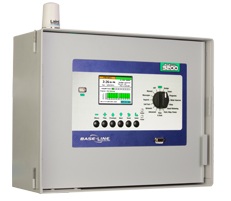
“X” Series Enclosure
- Large metal wall mount enclosure
- 15.50”W x 12.38”H x 6.40”D
- Available in 16-gauge steel, powder coated (X) & 16-gauge, 304-grade stainless steel (XS)
- Interior/exterior mount
- Compatible with R-Series Powered biCoders – holds up to 48 conventionally wired zones
- Compatible with any communication module
How to Specify: BL-3200X or BL-3200XS
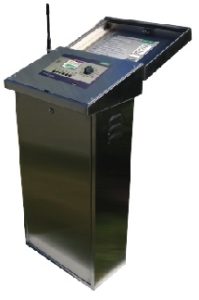
“P” Series Pedestals
- Standard stainless steel pedestal enclosure
- 17.38”W x 36.25”H x 12.63”D
- 16-gauge, 304-grade stainless steel
- Compatible with R-Series Powered biCoders – holds up to 48 conventionally wired zones
- Compatible with any communication module
How to specify: BL-3200P
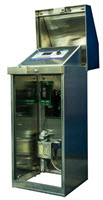
“PSS” Series Pedestals
- Super strong stainless steel pedestal enclosure
- 16”W x 38”H x 15.5”D
- 16-gauge, 304-grade stainless steel
- Compatible with R-Series Powered biCoders – holds up to 48 conventionally wired zones
- Compatible with any communication module
- Has a stainless steel cam style lock mounted in the lid and a provision for a padlock included within the locking mechanism.
How to specify: BL-3200PSS
3. Next, Choose a Communication Option
- Ethernet port is built-in!
- “-WF” Wi-Fi Modem
- “-CM” Cellular Modem
- “-ER” Ethernet Radio (900+ MHz Spread Spectrum Radio)
How to Specify: BL-3200X-WF or BL-3200P-CM
4. Finally, Specify Two-Wire or Conventional Wire
Every BaseStation 3200S controller is two-wire ready. Any BaseStation 3200S controller can work with a conventional wire site with Baseline Powered biCoders. Add up to 48 conventional wire terminal stations to any BaseStation 3200S. Baseline Powered biCoders are available in 12 and 24 station configurations. Specify the conventional wire station count by adding “-R12”, “-R24”, “-R36”, “-R48” to any BaseStation 3200S part number.
How to Specify: BL-3200X-WF-R48
Every BaseStation 3200S is capable of controlling up to 200 zones in any combination of two-wire and conventional wire. Combine multiple existing small-station-count controllers into one controller by replacing one of the old controllers with a BaseStation 3200 and one or more old controllers with Powered biCoders (BL-5200X or BL-5200C) in their own enclosures.
Note: Each BL-5200 Powered biCoder must be connected to a BaseStation 3200 with a two-wire path. Please see the Two-Wire Specification for wire specifications.
How to Specify the Communication Modules
4G Cell Modem
When a 4G cell modem is ordered with a Baseline irrigation controller, the cell modem is factory installed inside the controller enclosure. A 3dB “salt shaker” antenna and cables are included.
Cell Modem Part Numbers
| BL-CLOUD-LTE-AT-X | 4G AT&T cell modem module for BL-1000, BL-3200, and SubStation controllers in X or XS cabinet. |
| BL-CLOUD-LTE-VZ-X | 4G Verizon cell modem module for BL-1000, BL-3200, and SubStation controllers in X or XS cabinet. |
| BL-CLOUD-LTE-AT-P | 4G AT&T cell modem module for BL-1000, BL-3200, and SubStation controllers in pedestal. |
| BL-CLOUD-LTE-VZ-P | 4G Verizon cell modem module for BL-1000, BL-3200, and SubStation controllers in pedestal. |
| BL-CLOUD-LTE-AT-SS | 4G AT&T cell modem module for BL-1000, BL-3200, and SubStation controllers for SB-16SS conversion kit. |
| BL-CLOUD-LTE-VZ-SS | 4G Verizon cell modem module for BL-1000, BL-3200, and SubStation controllers for SB-16SS conversion kit. |
| BL-CLOUD-LTE-AT-CSSE | 4G Verizon cell modem module for BL-1000, BL-3200, and SubStation controllers Calsense SSE conversion kit. |
| BL-CLOUD-LTE-AT-PSS | 4G AT&T cell modem module for BL-1000, BL-3200, and SubStation controllers in SB-16SS VIT pedestal. |
| BL-CLOUD-LTE-VZ-PSS | 4G Verizon cell modem module for BL-1000, BL-3200, and SubStations controllers in SB-16SS VIT pedestal. |
External Antenna Options for Cellular Modules (compatible with all BL-CM-C, BL-CM-X, and BL-CM-P modules)
Includes mast-mounted antenna with mounting brackets, waterproof pipe/conduit mount connector, internal N-type bulkhead, mounting brackets and screws for C and X cabinets, and P pedestals, and installation instructions. Requires BL-CX or compatible LMR-400 low loss cable.
| BL-CM-OMNI | Omnidirectional high gain antenna kit |
| BL-CM-DIR | Directional high gain antenna kit |
Ethernet Radio
When an Ethernet radio module is ordered with a Baseline irrigation controller, the Ethernet radio is factory installed inside the controller enclosure. A 3dB “salt shaker” antenna and cables are included.
| BL-ER-C | Ethernet radio module (factory configured as a Gateway) in metal wall mount cabinet with 3dB integrated antenna for BL-1000 and BL-3200 controllers. Can also be configured as a Repeater. |
| BL-ER-X | Ethernet radio module for X/XS cabinet with 3dB integrated antenna for BL-1000 and BL-3200 controllers |
| BL-ER-P | Ethernet radio module for pedestal with 3dB antenna and stainless-steel antenna mount for BL-1000 and BL-3200 controllers |
External Antenna Options for ER Radio Modules (compatible with all BL-ER-C, BL-ER-X, and BL-ER-P modules)
Includes mast-mounted antenna with mounting brackets, waterproof pipe/conduit mount connector, internal N-type bulkhead, mounting brackets and screws for C and X cabinets, and P pedestals, and installation instructions. Requires BL-CX or compatible LMR-400 low loss cable.
| BL-CM-OMNI | Omnidirectional high gain antenna kit |
| BL-CM-DIR | Directional high gain antenna kit |
Wi-Fi Communication Modules
When a Wi-Fi communication module is ordered with a Baseline irrigation controller, the Wi-Fi module is factory installed inside the controller enclosure. A 3dB “salt shaker” antenna and cables are included.
BaseStation 1000 Specific Wi-Fi Communication Modules
| BL-1000WF-X | Wi-Fi module for BL-1000 controllers in large wall mount cabinet |
| BL-1000WF-P | Wi-Fi module for BL-1000 controllers in stainless-steel pedestal |
BaseStation 3200 Specific Wi-Fi Communication Modules
| BL-3200WF-C | Wi-Fi module for BL-3200 controllers in its own metal wall mount cabinet |
| BL-3200WF-X | Wi-Fi module for BL-3200 controllers in large wall mount cabinet |
| BL-3200WF-P | Wi-Fi module for BL-3200 controllers in stainless-steel pedestal |
External Antenna Options for Wi-Fi Modules (compatible with all BL-3200WF, BL-1000WF controllers)
Includes mast-mounted antenna with mounting brackets, waterproof pipe/conduit mount connector, internal N-type bulkhead, mounting brackets and screws for C and X cabinets, and P pedestals, and installation instructions. Requires BL-CX or compatible LMR-400 low loss cable.
| BL-CM-OMNI | Omnidirectional high gain antenna kit |
| BL-CM-DIR | Directional high gain antenna kit |
Accessories
| BL-ETH-SW | Ruggedized 3-Port Ethernet Switch |
| BL-CX-CBL10 | 10′ coaxial antenna cable |
| BL-CX-CBL25 | 25′ coaxial antenna cable |
| BL-CX-CBL50 | 50′ coaxial antenna cable |
| BL-CX-CBL75 | 75′ coaxial antenna cable |
| BL-CX-CLB100 | 100′ coaxial antenna cable |
| BL-CX-CBL125 | 125′ coaxial antenna cable |
| BL-CX-LA | In-line surge arrestor for external antennas. Compatible with all wall mount and pedestal CM, MR, and WF units. |
Baseline’s Communication Modules
4G Cell Modem
Add a 4G LTE cell modem communication module to your BaseStation irrigation controller to enable reliable remote connectivity. The cell modem sends and receives data over a wireless carrier’s 4G network.
When you choose a cell modem communication package from Baseline, we provide the cell modem hardware, the antenna, the SIM card from the wireless carrier, the firmware that activates the connection from your controller.
We do not charge for cellular data.
2.4 GHz Wi-Fi
Add a Wi-Fi communication module to your BaseStation irrigation controller to enable reliable wireless connectivity. The Wi-Fi module sends and receives data over an existing Wi-Fi network at your site.
When you choose a Wi-Fi module communication package from Baseline, we provide the Wi-Fi module and the firmware that activates the connection from your controller.
RJ45 Ethernet Port
All Baseline controllers ship with an active RJ45 Ethernet port for direct-connect Ethernet cables. The Ethernet port allows the controller to send and receive data over an existing network at your site.
Ethernet Radio
Ethernet radios are a good solution for wireless communication at a large site with multiple controllers that do not have access to another type of Internet connection. Ethernet radios establish a wireless network across a large site, and all Baseline controllers can use this network to send and receive data.
The typical configuration for a large site is one Gateway radio in its own enclosure and an Endpoint radio in each BaseStation controller. In cases where a controller does not have adequate signal strength to connect to the rest of the network, an additional Gateway radio can be configured as a Repeater to boost the signal to the outlying controller. Keep in mind, however, that using a Repeater will reduce the data speed on the network by 50 percent or more.
After the network for the radios is set up and communicating, the Gateway radio unit is connected via Ethernet to the site’s local area network (LAN). Then, the radio network can send and receive data over the Internet.
When you are planning to use Ethernet radio communication, a Site Survey should ALWAYS be performed.


